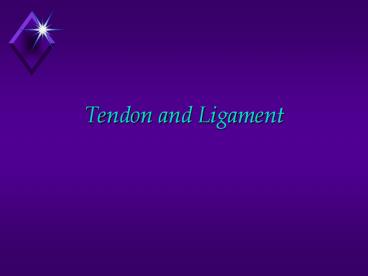Tendon and Ligament PowerPoint PPT Presentation
Title: Tendon and Ligament
1
Tendon and Ligament
2
Roles of Ligaments and Joint Capsules
- Assist in Stabilization of Joint
- Restrict Movement
- Prevent Excessive Motion
3
Roles of Tendons
- Attach muscle to bone
- Transmit tensile loads
- Position of muscle relative to joint
4
Mechanical Behavior of Tendons and Ligaments
- Both are viscoelastic tissues
- Visco - a small amount of load results in quite a
bit of deformation (relative) - Elastic - refers to Elastic Region
- Importance of viscoelastic qualities?
5
Properties of Tendon
- can sustain high tensile loads
- flexible to allow changes in direction of muscle
pull
6
Properties of Ligament
- guides movement
- resists applied force
7
Mechanical Propertiesof Tendon and Ligament
- Strength
- Stiffness
8
Damage to Tendon and Ligament
- When load is great enough to cause injury, damage
is dependent on - rate and
- amount of load
9
Load-Deformation Curvefor Tendon and Ligament
- (0,0) - A Toe Region
- A - B Elastic Region
- B Yield Point
- B - C Plastic Region
- C Ultimate Failure Point
10
Comparison of Bone toTendon and Ligament
- Identify similarities and differences between
these tissue types.
11
Mechanical Properties ofTendon and Ligament
- Strength
- Stiffness
12
Injury Mechanisms
- Injury occurs when tissue is loaded beyond its
physiological range. - Microfailure occurs before the yield point is
reached.
13
Injury Mechanisms cont.
- When yield point is exceeded, the ligament begins
to undergo gross failure. - Results in abnormal joint displacement
- Displacement results in...
14
3 Clinical Categories ofLigament Injury
- Negligible Clinical Symptoms (Grade 1)
- no joint instability can be detected clinically
- Severe Pain (Grade 2)
- joint instability can be detected clinically
- strength and stiffness decreases by 50
- instability can be masked by muscle involvement
15
3 Clinical Categories ofLigament Injury cont.
- Severe Pain (Grade 3)
- severe pain experienced during the injury with
less pain after the injury - joint is completely unstable
- most collagen fibers have ruptured
16
Noyes Study (1977)
- Rhesus monkeys
- 8 wks immobilization
- returned to mobilization
- at 12 mo. mechanical properties were comparable
to non-immobilized ligaments. - Drumroll?
17
Additional Factors Importantin Tendon Injury
- Amount of force produced by muscle
- Stress comparison between tendon and muscle
- Loading Rates
18
Factors Affecting Biomechanical Properties of
Tendon and Ligament
- Aging
- Pregnancy
- Mobilization vs. Immobilization
- NSAIDs
19
Osteoarthritis
- Researchers suggest that a deficiency in
mechanisms that minimize peak forces may cause
osteoarthritis.

